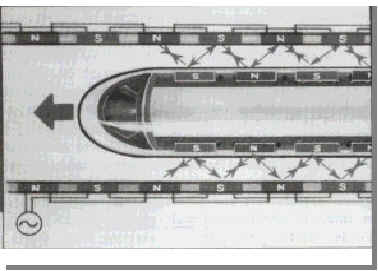Maglev trains are the future of high-speed trains. Maglev combines the benefits of airplanes with the benefits of trains to create "flying trains". Maglev trains use electromagnetic technology to allow trains to actually hover above the ground. With the friction of wheels on rails gone, a whole new era of high-speed trains is possible. Tracks for maglev trains are different from those of conventional trains. They are elevated above ground, allowing everything else to go underneath it, and nothing will stand in the way of 300mph trains. Maglev trains use the simple technology of magnets to raise the train of the ground, hence the name "Maglev". Everyone knows that if you put two magnets together in a certain way there will be a strong magnetic attraction and the two magnets will clamp together. This is called "attraction". If one of those magnets is flipped over then there will be a strong magnetic repulsion and the magnets will push each other apart. This is called "repulsion". Now imagine a long line of magnets alternately placed along a track. And a line of alternately placed magnets on the bottom of the train. If these magnets are properly controlled the trains will lift of the ground by the magnetic repulsion or magnetic attraction. The power of the magnets can also be controlled to move the train forward, and fast.

How maglev trains operate?: Japanese maglev train moves by the force of the magnets. Currently, maglev trains have been created in Germany and Japan for test runs only. No commercial trains are operating. Germany and Japan are using two different types of maglev trains. Germany is using the power of magnetic "attraction", while Japan is mostly using magnetic "repulsion". In Germany the bottom of Maglev trains wrap around the track leaving only a 3/8 of an inch gap between the train and the track while in motion. In Japan, maglev trains have magnetic tracks underneath the trains as well as on the sides of the bottom part of the train. The magnets on the side of the track correspond with those on the side of the train while the magnets on the bottom of the track correspond with those underneath the train. The maglev trains in Japan have a 4-inch gap between the train and the track while in motion. When the trains in Japan slow down as they come into the station, wheels underneath the train reattach to the ground eventually bringing the train to a stop.
How fast can they go? On test runs maglev trains have been able to exceed 300mph. In Germany the top speed of a maglev train was 312mph and Japan's maglev trains reached 323mph in 1979 shattering the record books. With advances on maglev trains, people say it will be able to go 600mph to 1000mph in the future. If maglev trains succeed they will revolutionize the way we get around and dramatically reduce travel time.
Are Maglev trains safe? Maglev trains have proven to be exceptionally safe, quiet, and fast. Because there's no friction with the ground, maglev trains are much quieter than trucks and automobiles. The only sound caused by the trains is the whoosh as the train goes by from the air friction. Farmers in Germany who have trains running over their fields, when asked about how the feel about the trains running through their farm replied "We don't even know it's there". Cows don't even lift their heads when trains come through at 250mph. Maglev trains are also almost accident free. They are above any obstacles on the ground and are enclosed in or around the track. Also the propulsion system caused by the magnetic fields disallows trains to come to close to other trains on the track. German Maglev goes over farm exceeding 200mph, but is so quiet the cows don't even look up at it. Another issue with maglev trains is whether the magnetic waves , or electromagnetic fields caused by the train will harm the passengers or people living along the lines. Studies have shown that the trains generate minimal magnetic fields, not nearly enough to harm people around the track or any sensitive machinery. The tracks themselves do not generate any electromagnetic fields. The only time the magnetic waves are present is when the trains go by which is only a short time, especially when they go by at 300mph. The magnetic field inside the cabin of the trains is just barely higher than earth's normal magnetic field. So if test runs go all right we could have fast, flying trains operating in the near future. —Ashutosh Dighe [D9]
